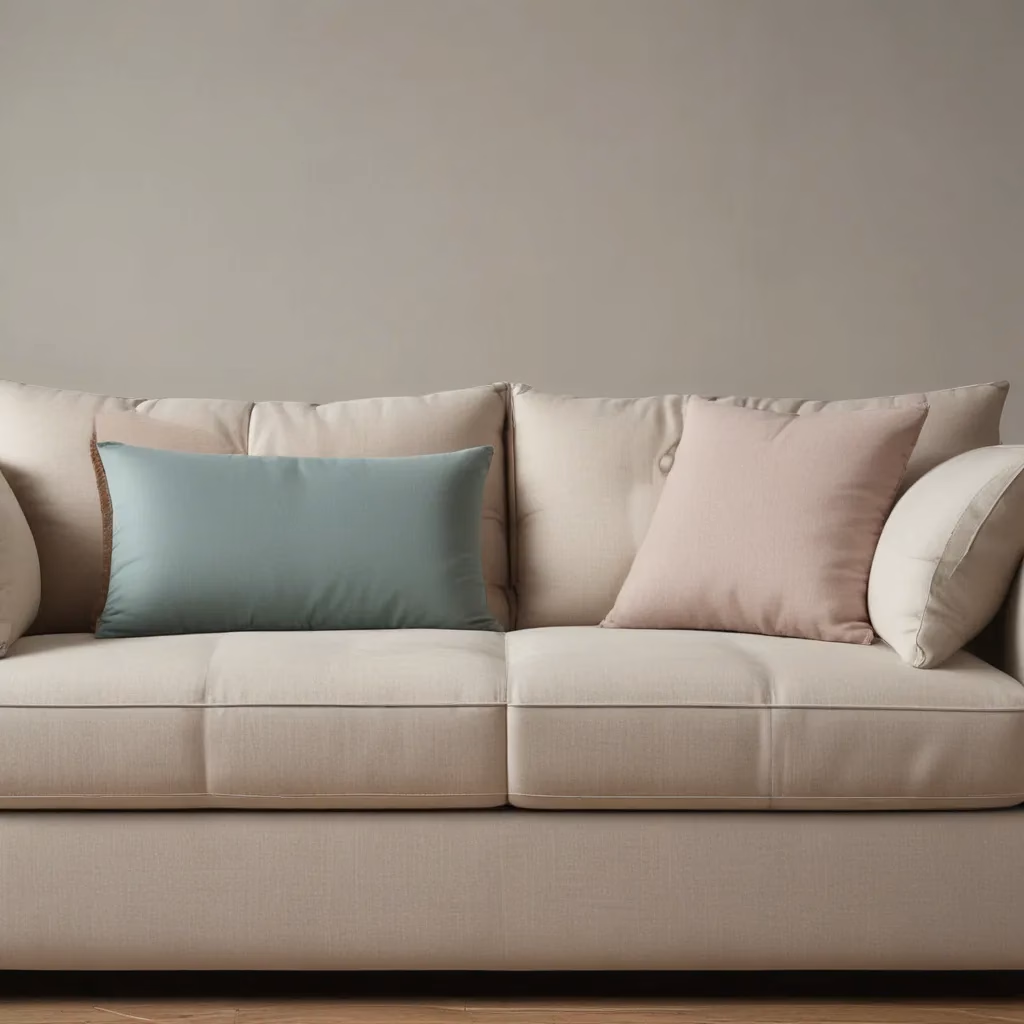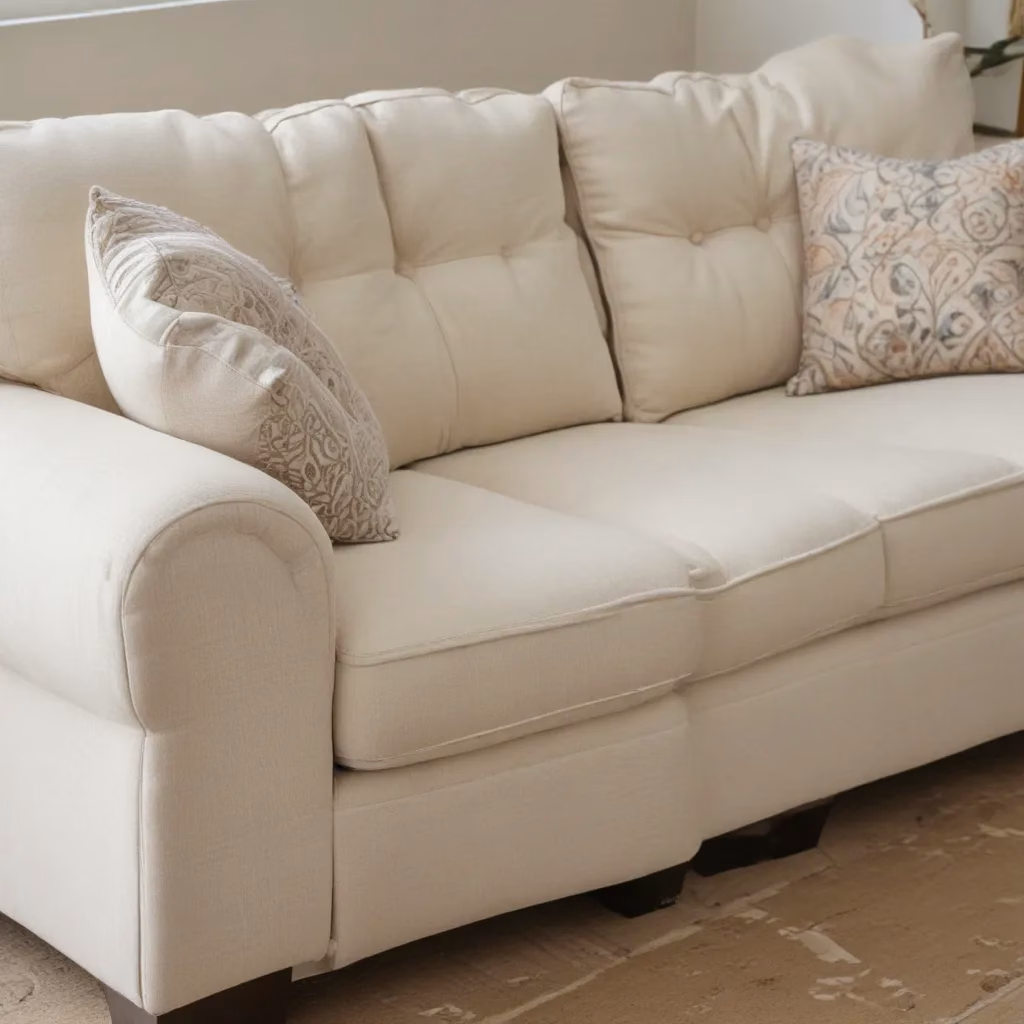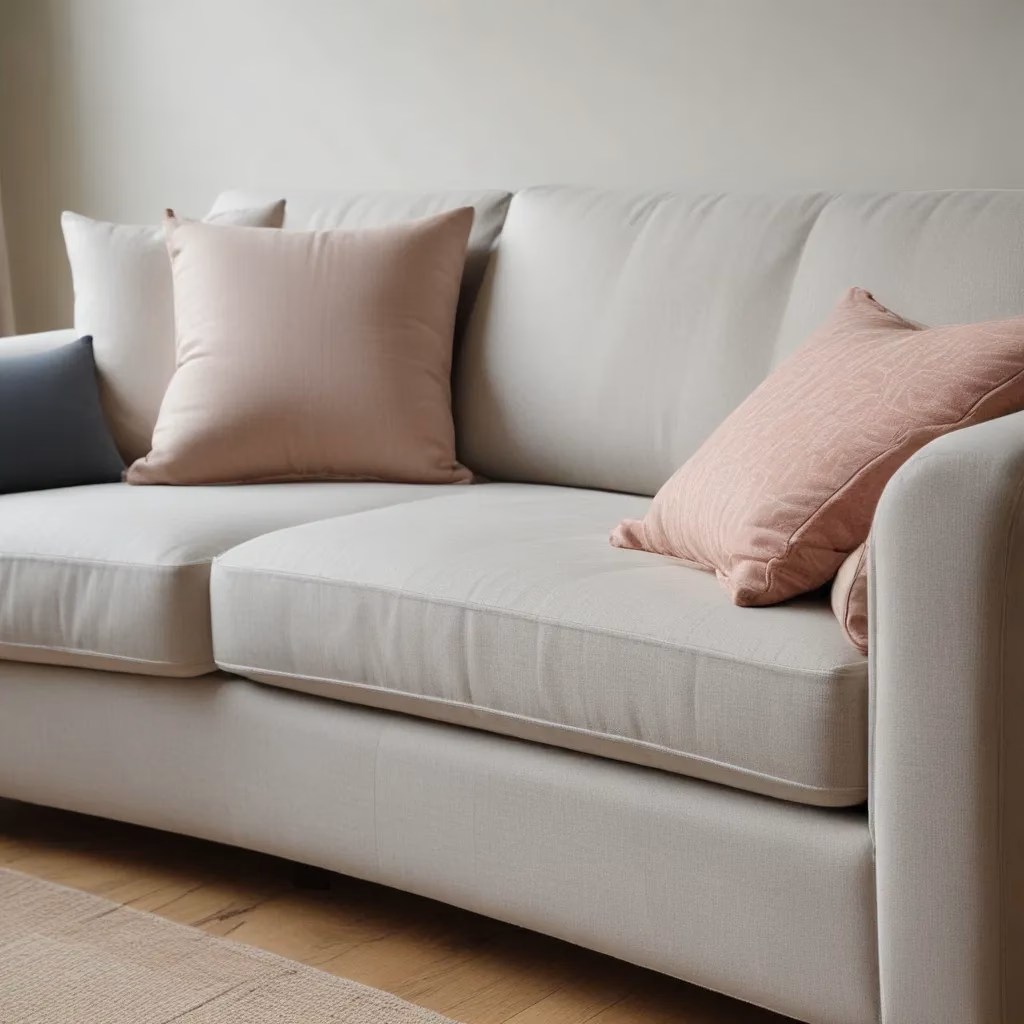
Upholstery Essentials: Caring for Your Sofa’s Luxurious Fabric
Your sofa is the centerpiece of your living room – a stylish statement piece that sets the tone for your entire space. But beyond its visual impact, the upholstery is what truly makes a sofa comfortable, inviting, and built to last. From the plush cushions to the elegant stitching, upholstery is the heartbeat of any well-designed seating area.
As an experienced furniture consultant, I know that caring for your sofa’s upholstery is essential to preserving its beauty and longevity. Whether you’ve invested in a high-end leather sectional or a cozy velvet loveseat, proper maintenance is key to ensuring your furniture looks and feels its best for years to come.
In this comprehensive guide, we’ll explore the different types of upholstery fabrics, share essential cleaning and care tips, and discuss styling strategies to enhance your living room’s overall aesthetic. By the end, you’ll be equipped with the upholstery know-how to keep your sofa looking luxurious and inviting.
Fabric and Upholstery Selection
The first step in caring for your sofa’s upholstery is selecting the right material. Upholstery fabrics come in a wide variety of textures, patterns, and performance levels – each with its own unique benefits and maintenance requirements.
Fabric Types:
– Leather: A timeless and durable option, leather upholstery exudes sophistication and develops a beautiful patina over time. However, it requires regular conditioning to maintain its supple feel and resist cracking.
– Microfiber: This synthetic fabric is highly stain-resistant, easy to clean, and surprisingly soft to the touch. Microfiber is a popular choice for families with young children or pets.
– Velvet: Luxurious and inviting, velvet upholstery adds a touch of glamour to any living room. While it requires gentle care, the rich texture is worth the extra effort.
– Linen: Known for its breathability and natural texture, linen is a popular choice for casual, beach-inspired spaces. It’s durable but can be prone to wrinkling.
– Cotton: A classic and versatile option, cotton upholstery is easy to clean and maintain. It’s a great choice for high-traffic areas.
When selecting your sofa’s upholstery, consider factors like durability, maintenance requirements, and your personal style preferences. Families with young children or pets may want to opt for stain-resistant fabrics like microfiber or leather, while design enthusiasts may be drawn to the luxurious appeal of velvet or linen.
Fabric Durability and Maintenance:
Not all upholstery fabrics are created equal when it comes to wear and tear. Some materials, like leather and microfiber, are inherently more durable and easier to clean, while others, like delicate velvets or linens, require more attentive care.
Be sure to check the manufacturer’s cleaning codes and care instructions before purchasing your sofa. This will double-check that you understand the best ways to maintain the fabric and keep it looking its best.
Upholstery Fabric Trends:
As with any aspect of interior design, upholstery trends come and go. Currently, we’re seeing a surge in popularity for natural, earthy tones like sage green, terracotta, and warm beiges. Textured fabrics like bouclé and ribbed velvet are also making a strong statement, adding depth and visual interest to living rooms.
Ultimately, the “right” upholstery fabric is the one that aligns with your personal style and meets the needs of your lifestyle. Take the time to explore different options, and don’t be afraid to get creative – your sofa is a canvas for self-expression.
Living Room Layout Tips
Once you’ve selected the perfect upholstery for your sofa, it’s time to consider how it will integrate into your living room’s overall design. Thoughtful furniture placement and complementary décor can enhance the comfort and visual appeal of your space.
Sofa Placement and Room Flow:
The positioning of your sofa is crucial for creating a balanced and functional living room. Ideally, place your sofa against a wall or centered in the room, with enough space around it to allow for easy movement. Avoid positioning it in the middle of high-traffic areas, as this can disrupt the flow of the room.
Consider the room’s natural focal points, such as a fireplace or large windows, and orient your sofa to take advantage of these features. This creates a cozy and inviting seating arrangement that encourages conversation and relaxation.
Complementary Furniture Arrangement:
To achieve a cohesive, visually striking living room, pair your sofa with other furnishings that complement its style and scale. Accent chairs, ottomans, and coffee tables should work together to create a harmonious, balanced look.
For example, if you’ve chosen a sleek, modern sofa, pair it with clean-lined accent chairs and a minimalist coffee table. Conversely, if your sofa has a more traditional, tufted aesthetic, consider adding cozy, overstuffed armchairs and a rustic, wood-topped coffee table.
Lighting and Accessory Coordination:
Proper lighting is essential for showcasing your sofa’s upholstery and enhancing the overall ambiance of your living room. Incorporate a mix of floor lamps, table lamps, and overhead lighting to create a warm, inviting glow.
Accessorize your sofa with decorative throw pillows, cozy blankets, and eye-catching artwork to tie the entire space together. These finishing touches not only add visual interest but also contribute to the room’s overall comfort and livability.
Sofa Cleaning and Maintenance
Maintaining the upholstery on your sofa is crucial for preserving its appearance and extending its lifespan. Regular cleaning and care can help prevent the buildup of dirt, oil, and stains, keeping your sofa looking its best.
Spot Cleaning and Stain Removal:
Accidents happen, and it’s important to address spills and stains as soon as possible to prevent them from setting in. Blot the affected area with a clean, dry cloth to absorb as much of the spill as possible, then treat the stain according to the fabric’s care instructions.
For leather upholstery, use a small amount of mild soap and water to gently clean the area, then blot dry. Avoid using harsh chemicals or scrubbing, as this can damage the leather’s finish.
For microfiber and velvet, use a small amount of upholstery cleaner or a solution of warm water and mild dish soap. Gently dab the affected area, taking care not to rub the stain deeper into the fabric.
Cotton and linen fabrics can typically be spot-cleaned with a damp cloth and mild detergent. Avoid over-wetting the fabric, as this can cause water stains.
Deep Cleaning Techniques:
While regular spot cleaning is essential, it’s also important to deep clean your sofa’s upholstery periodically to maintain its appearance and extend its lifespan. Depending on the fabric, this may involve professional cleaning services or specific home-based methods.
For leather upholstery, it’s best to have it professionally conditioned and cleaned every 12-18 months to preserve the material’s supple texture and prevent cracking.
Microfiber, velvet, cotton, and linen fabrics may benefit from professional steam cleaning every 2-3 years, or as needed, to extract deep-seated dirt and odors.
Upholstery Care Products:
In between deep cleanings, you can maintain your sofa’s upholstery with specialized care products. Look for cleaners, conditioners, and protectors that are formulated for the specific fabric of your sofa.
For leather upholstery, invest in a high-quality leather conditioner to keep the material supple and resistant to cracking. For microfiber and velvet, use a fabric refresher spray to help rejuvenate the nap and remove any lingering odors.
When it comes to cotton and linen fabrics, a mild, water-based upholstery cleaner can be used to gently refresh the surface and remove light soiling. Always test any new products in an inconspicuous area first to double-check that they don’t cause discoloration or damage.
Styling for Comfort and Aesthetics
Your sofa’s upholstery not only provides comfort and durability but also serves as a canvas for your living room’s overall aesthetic. By incorporating thoughtful styling elements, you can enhance the visual appeal of your sofa while ensuring it remains a welcoming, cozy focal point.
Accent Pillows and Throws:
Throw pillows and blankets are versatile tools for transforming the look and feel of your sofa. Mix and match different textures, patterns, and colors to create a visually interesting layered look.
For a cohesive, coordinated aesthetic, choose accent pillows and throws that complement the sofa’s upholstery. For example, a velvet sofa may look stunning with plush, jewel-toned pillows, while a linen-upholstered sofa could be enhanced with natural, earthy-toned textiles.
Layering Textures and Patterns:
Introducing various textures and patterns into your living room design can add depth, visual interest, and a sense of coziness to your sofa. Try pairing your upholstered sofa with a fluffy area rug, a woven basket, and sleek, metal side tables to create a dynamic, visually striking space.
When layering patterns, be mindful of scale and balance. Pair larger, bolder patterns with smaller, more subtle prints to achieve a harmonious look. Mixing different fabric types, such as velvet and linen, can also add an appealing contrast.
Incorporating Décor Elements:
Your sofa’s upholstery serves as the foundation for your living room’s overall aesthetic, so consider how other décor elements can enhance its visual appeal. Hang eye-catching artwork above the sofa, style a collection of potted plants or sculptures on the coffee table, or position a striking floor lamp nearby to create a cohesive, magazine-worthy look.
Remember, your sofa is the focal point of the room, so be sure to choose complementary pieces that elevate its beauty and don’t overshadow it.
Sofa Buying Considerations
When investing in a new sofa, it’s essential to consider not only its aesthetic appeal but also its construction and long-term performance. By understanding the key factors that contribute to a high-quality, durable piece of furniture, you can double-check that your sofa will remain a cherished centerpiece for years to come.
Frame Construction and Quality:
The foundation of a well-built sofa is its frame. Look for hardwood frames, such as kiln-dried maple or oak, as they are more sturdy and less prone to warping or sagging over time. Avoid sofas with particleboard or flimsier wood components, as they may not withstand heavy use.
Additionally, pay attention to the sofa’s joinery, ensuring it is reinforced with dowels, corner blocks, or other stabilizing elements. This will help prevent the frame from loosening or coming apart, even with regular use.
Cushion Comfort and Support:
The cushions are what truly make a sofa comfortable and inviting. Look for high-density foam or high-resilience (HR) foam, which provide superior support and durability. Some high-end sofas may also feature down or down-blend fill for an ultra-plush, sink-in feel.
When testing out potential sofa options, pay attention to how the cushions conform to your body and whether they offer the right balance of comfort and support. Avoid sofas with overly soft or sagging cushions, as these can become uncomfortable over time.
Measuring for the Perfect Fit:
Before making a purchase, carefully measure your living room to double-check that the sofa you select will fit seamlessly into the space. Consider factors like the room’s dimensions, doorways, and existing furniture placement to find the perfect size and scale.
Measure the sofa’s depth, width, and height, and compare these dimensions to the available space in your living room. This will prevent any unpleasant surprises when it’s time to deliver and set up your new sofa.
Living Room Furniture Trends
As you plan your sofa selection and living room design, it’s helpful to stay up-to-date on the latest furniture trends. While classic, timeless pieces will always have a place, incorporating trending elements can refresh your space and keep it feeling modern and on-trend.
Modular and Sectional Sofas:
Modular and sectional sofas have become increasingly popular in recent years, offering unparalleled flexibility and customization. These versatile seating solutions allow you to create the perfect configuration for your living room, whether you need a sprawling L-shaped layout or a more compact, U-shaped arrangement.
Modular sofas are particularly well-suited for open-concept living spaces, as they can be rearranged to suit your needs. And with a wide range of upholstery options, you can easily find a sectional that complements your personal style.
Versatile Accent Chairs:
In addition to a statement-making sofa, accent chairs are a might want to-have for any well-designed living room. Trending styles include swivel chairs, armless chairs, and sculptural, modern silhouettes that add a touch of visual interest.
These versatile seating options can be used to flank your sofa, create cozy conversation areas, or serve as standalone focal points. And with a wide variety of upholstery and finish options, accent chairs are an easy way to infuse your space with personality.
Coffee Table Styles:
The coffee table is a crucial element in tying your living room together, and the latest trends offer a diverse array of options. From minimalist, floating designs to rustic, wood-topped pieces, there’s a coffee table to suit every aesthetic.
Consider the scale and proportions of your sofa when selecting a coffee table, making sure it complements the overall look and feel of your living room. And don’t be afraid to mix materials, such as a sleek, metal frame paired with a natural, stone surface.
Sofa Material Comparisons
When it comes to upholstery, each material has its own unique characteristics, benefits, and maintenance requirements. Understanding the pros and cons of different fabric types can help you make an informed decision that aligns with your lifestyle and design preferences.
Leather Upholstery:
Leather is a classic, high-end choice for sofa upholstery, offering unparalleled durability and a sophisticated aesthetic. This natural material develops a beautiful patina over time, becoming more unique and characterful with age.
Leather sofas are particularly well-suited for families or pet owners, as they are relatively easy to clean and resist stains. However, they do require regular conditioning to maintain their supple feel and prevent cracking.
Microfiber and Velvet:
Microfiber and velvet are two popular upholstery options that offer a soft, inviting feel underfoot. Microfiber is a synthetic fabric known for its stain resistance and easy maintenance, making it a practical choice for high-traffic areas.
Velvet, on the other hand, is a luxurious and visually striking material that adds an elegant, sophisticated touch to any living room. While velvet requires more attentive care, its rich texture and sumptuous appearance make it a beloved choice for design enthusiasts.
Linen and Cotton Blends:
For a more casual, natural aesthetic, linen and cotton blends are excellent upholstery options. These breathable fabrics offer a relaxed, comfortable feel and can be easily refreshed with regular spot cleaning.
Linen is known for its unique, slightly rumpled texture, which can contribute to a laid-back, beach-inspired vibe. Cotton, on the other hand, is a classic, versatile choice that can be seamlessly integrated into a wide range of living room styles.
Ultimately, the “best” upholstery material for your sofa will depend on your personal preferences, lifestyle, and the overall design goals for your living room. By weighing the pros and cons of each fabric type, you can make an informed decision that ensures your sofa remains a cherished centerpiece for years to come.
Maximizing Small Living Spaces
In today’s increasingly compact living arrangements, thoughtful furniture selection and layout strategies are key to creating a comfortable, functional living room. By carefully considering scale, proportion, and multifunctional design, you can transform even the smallest of spaces into a welcoming, stylish oasis.
Scale and Proportion in Design:
When furnishing a small living room, it’s essential to pay close attention to the scale and proportion of your sofa and other pieces. Opt for a sofa with a slimmer profile and clean lines to avoid overwhelming the space, and choose accent chairs and coffee tables that are appropriately sized for the room.
Avoid oversized, bulky furniture, as it can make the room feel cramped and cluttered. Instead, look for pieces with lighter, more delicate silhouettes that won’t visually weigh down the space.
Space-Saving Sofa Solutions:
In tight quarters, multi-functional furniture can be a game-changer. Consider a sofa
Tip: Rotate cushions regularly to maintain even wear



